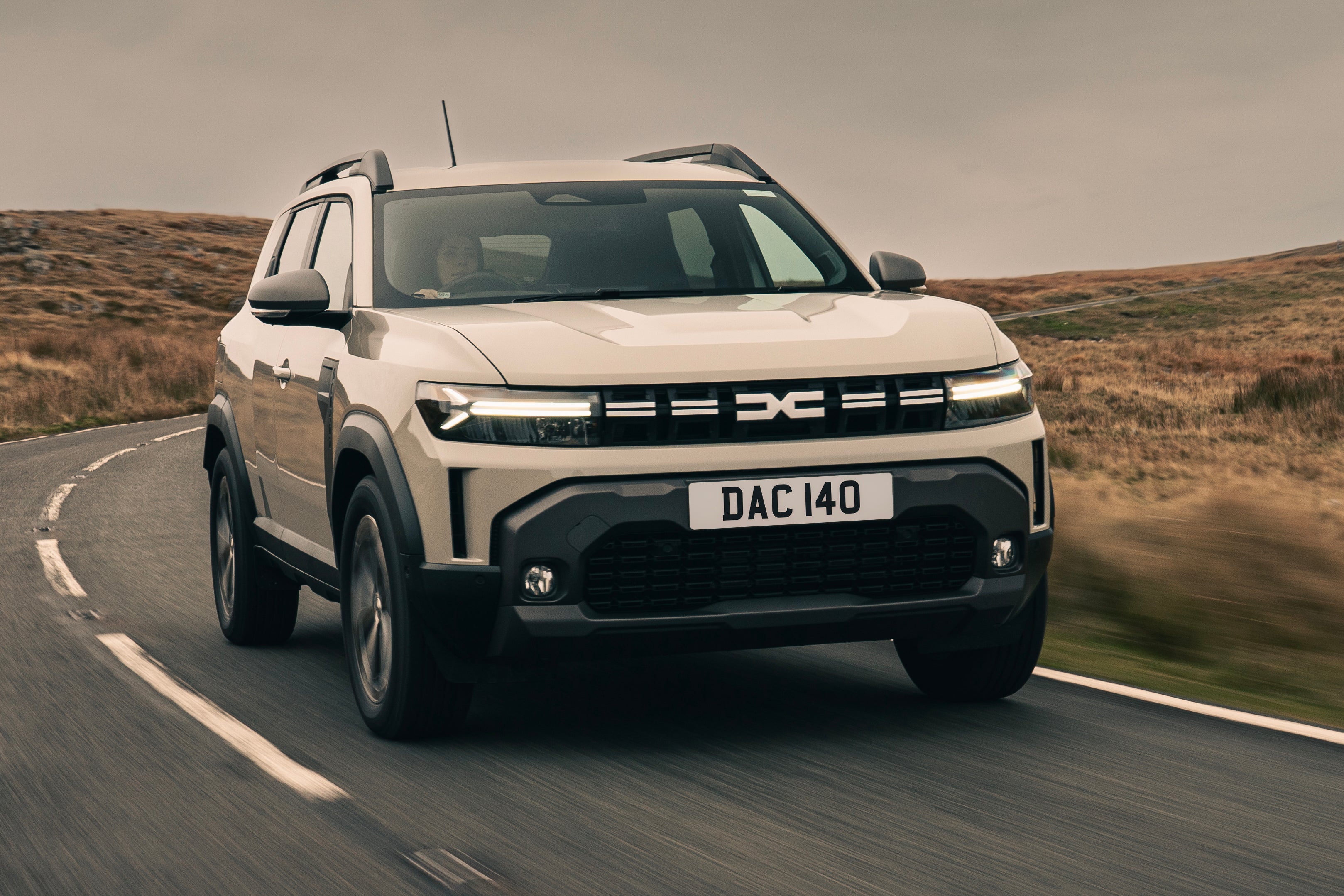Dacia Duster Review 2025: Price, specs & boot space
Written by Al Suttie
Quick overview
Pros
- Full-hybrid power option
- Surprisingly good off-road ability
- Keen pricing
Cons
- Some cheap build elements
- Pointless LPG version
- Slow infotainment response
Verdict: Is the Dacia Duster a good car?
“The third-generation of Dacia Duster builds on the success of its predecessors, and admirably. It's better to drive, more efficient, better looking and an all-round improvement that keeps Dacia's best-selling model at the top of the value-for-money SUV list.”
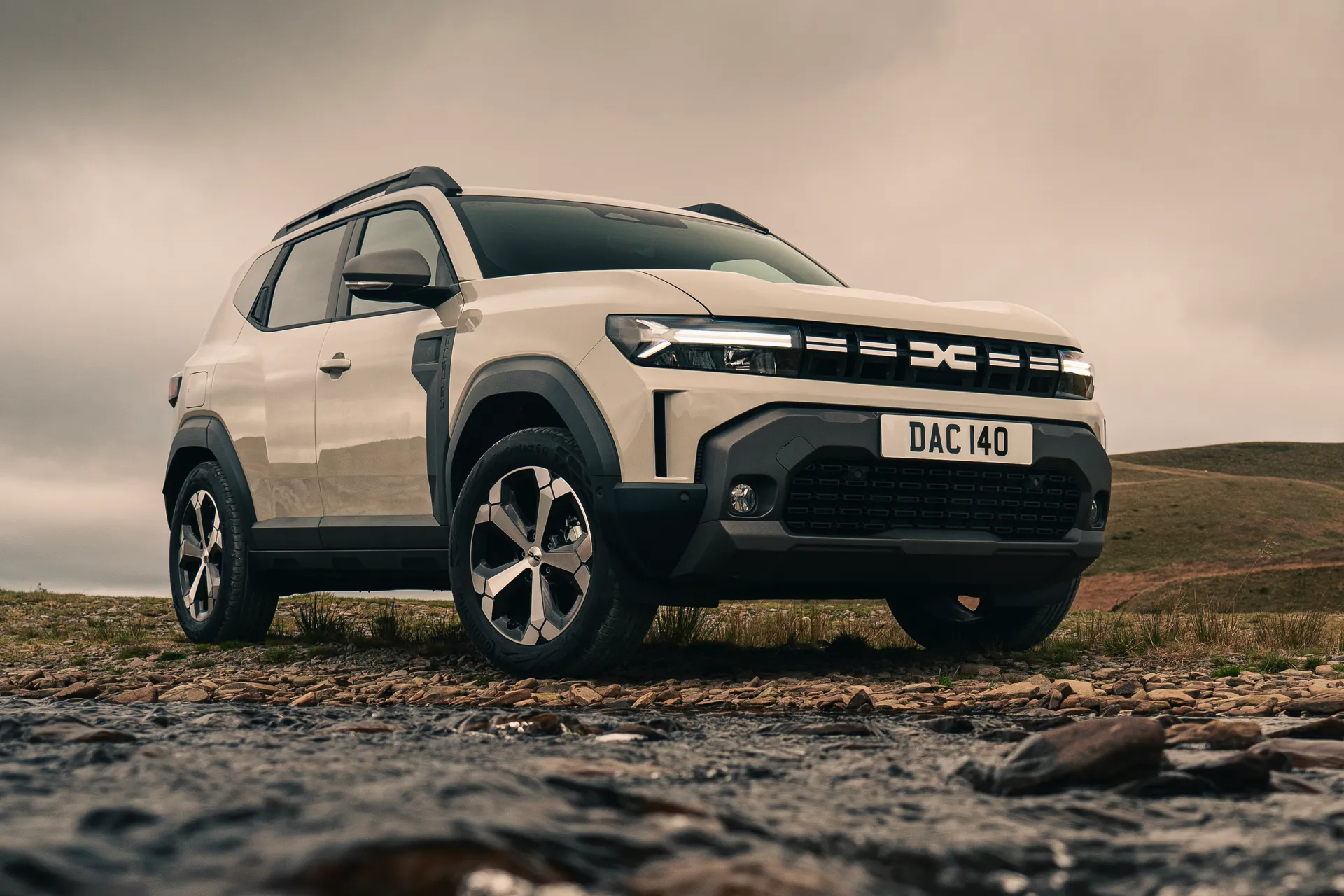
The Dacia Duster has been a smash hit for the once-little-known Romanian brand, now a subsidiary of Renault. The Duster forged a reputation as a very affordable but very competent family SUV, with the added extra of some off-road capability should you want it.
Now for the third generation of Duster, Dacia has redesigned it to have a more rugged design and a more upmarket look, but it's still very affordable compared to other cars of this type.
While the looks of the latest Dacia Duster are clearly an evolution of the previous model's, there's plenty to tell you at a glance this is a bang-up-to-date version. It's got new mechanical underpinnings and a chunkier design, with bolder Y-shape headlights and front grille.
Along the sides, you'll find wheelarch extensions made from what Dacia calls 'Starkle', a recycled material that's also used on the sill protectors. These are cheap and easy to replace should they get scuffed up. They aren't there just for show, either, as the Duster is impressive capable of tackling unmade tracks and rougher terrain if you fit chunkier tyres or choose the 4x4 version.
Engine choices include a three-cylinder, 1.2-litre TCe 130 mild-hybrid petrol unit and a 1.0-litre petrol engine able to run on LPG (liquid petroleum gas). However, if you want a proper hybrid-powered Dacia Duster, you'll need the Hybrid 140 model. It uses the same 1.6-litre petrol engine and electric motor combination found in other Renaults that share the Duster's mechanical underpinnings: more recycling in action, then. The downside to this version is that the EV range is limited and fuel consumption isn't much better than the 1.2-litre petrol version's.
On the road, the TCe 130 with front-wheel drive is all the Dacia Duster you're every likely to need. It has a peppy feel that belies its modest power and performance. While not as nippy as a Volkswagen T-Roc, it's in keeping with the Dacia Duster's more rugged appeal.
It's a similar story for the ride and handling. While not as agile as a Ford Puma, the Duster deals with corners in a calm, confident fashion, and there's noticeably less body lean than in the previous generation of Duster. Ragged road surfaces are dealt with ably and the steering is light around town yet sufficiently accurate on faster roads. Where the Dacia Duster trumps rivals is is greater ground clearance: with 217mm of space beneath the car, you simply don't worry if you have to dip a wheel into the verge on narrower lanes to avoid oncoming traffic.
Inside, there are plenty of wipe-clean surfaces to complement the Duster's rugged exterior. However, it's also comfortable and roomy enough front and back, and the boot is a generous size. Only some hard, low-grade plastics spoil the interior ambience, and the infotainment system is somewhat sluggish.
Would that put us off picking a Dacia Duster as a robust small family SUV? No, as the few downsides are far outweighed by the car's other charms and abundant talents.
Looking for a used car for sale? We've got 100s of Dacia Approved Used Cars for Sale for you to choose from, including a wide range of Dacia Duster cars for sale. If you're looking for the older version, you need our used Dacia Duster (2018-2024) review
Is the Dacia Duster right for you?
If you're more concerned about a car's ability than the badge on its snout, the Dacia Duster is probably already on your short list. It's a comfortable drive, boasts a simple engine line-up, and has the ability to go further off the beaten track than most rivals, which all give it a strong appeal.
With this latest generation of Dacia Duster, we'd also argue it now has an understated credibility and neatly detailed style to draw in a more hipster crowd.
What's the best Dacia Duster model/engine to choose?
Some buyers will choose the all-wheel-drive version of the Dacia Duster based purely on their needs, and they'll get a fine small SUV with goat-like abilities away from the tarmac. For the rest of us, the front-wheel-drive version with the 1.2-litre TCe 130 engine and six-speed manual transmission is the sweet spot. Go for the Journey trim and you get the larger infotainment screen with Apple CarPlay and Android Auto, plus a larger digital instrument cluster, automatic air conditioning, and 18-inch alloy wheels.
What other cars are similar to the Dacia Duster?
There's not much that is as rugged as the Dacia Duster in 4x4 spec, but it does have plenty of rivals when it comes to on-road driving. Prime among these are the Volkswagen T-Roc, Skoda Kamiq, and Ford Puma, which are all excellent to drive and sit in, but will cost you quite a bit more.
The Suzuki Vitara comes close in the rugged stakes, but a Peugeot 2008 or Renault Captur are more likely alternatives. If you want an EV rather than petrol engine, there's the Vauxhall Frontera.
Comfort and design: Dacia Duster interior
"This Duster pulls off the difficult balancing act of appearing rugged and utilitarian, while also looking surprisingly stylish in a cabin that works very well."
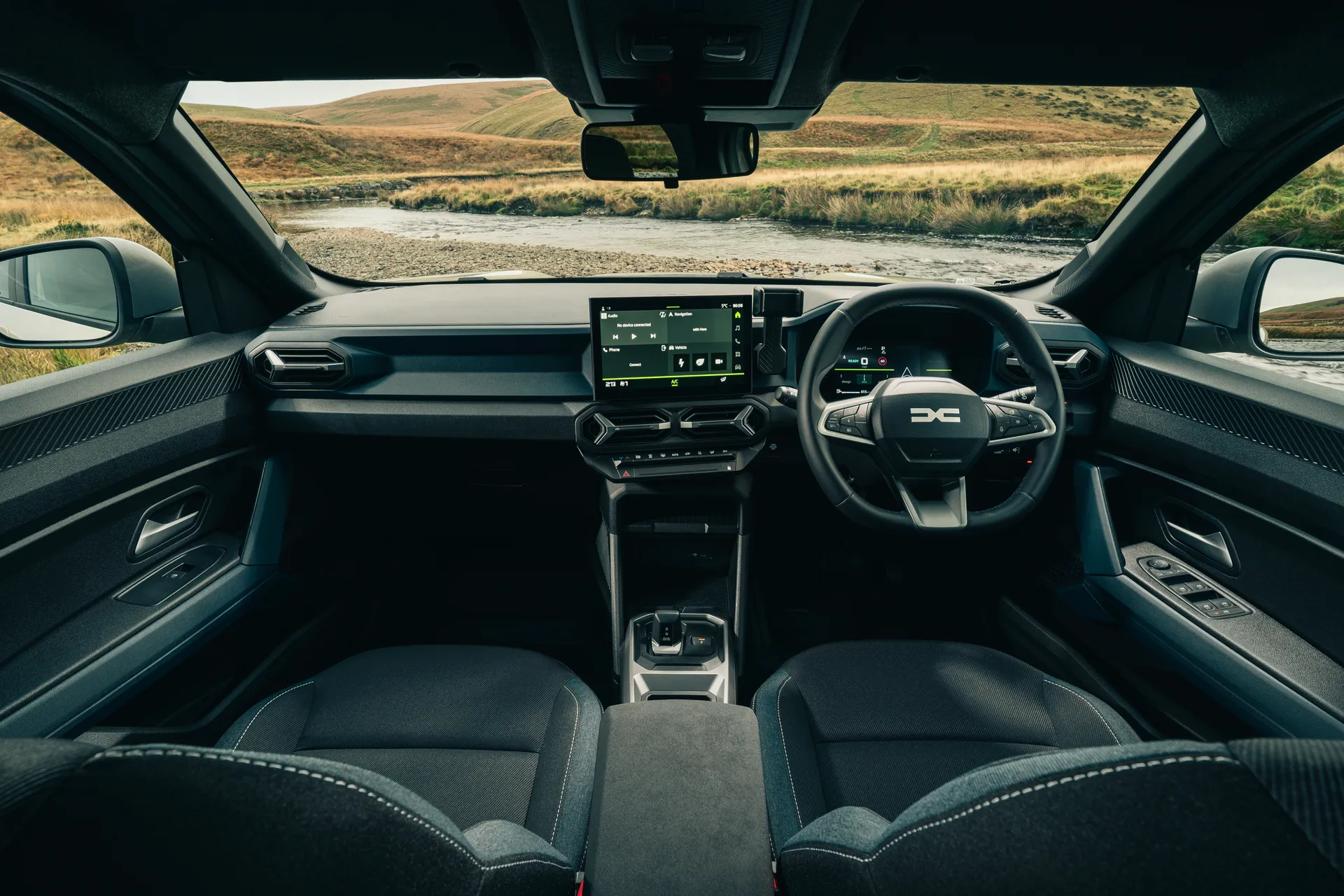
Dacia has done a very good job of disguising most of the Duster's bits that are shared with parent company Renault, especially in the higher trim models. As a result, the 7.0-inch digital instrument panel that's standard in all but the base trim looks crisp and right up to date, though it's not as configurable as those in some rivals.
The view of the instrument cluster is unhindered and you can adjust the steering wheel for height and reach. The driver's seat also moves for height, unless you pick the base trim, but we noticed that the front seats don't quite slide far enough back for some taller drivers and passengers. Still, they're nicely supportive and comfortable.
With the seat set, the driver has good vision in all directions. The Duster's square-set style also makes it easy to judge where the car's corners are when parking, and all versions come with rear parking sensors included.
We're fans of the design style that Dacia has gone for with this Duster. The cabin carries through themes from the exterior, such as the Y-shape seen in the Dacia logo and headlights. We also like that there are still some physical buttons for the heater controls rather than relying on the infotainment touchscreen controls.
Quality and finish
How well you perceive the Dacia Duster's quality will depend on your reference points. Compared to the previous generation model it's a noticeable improvement in fit, finish and feel. If, however, you've been tempted over from something like a Skoda, you might be a little disappointed.
There's nothing to quibble about with the way the Duster's interior is put together. There are no creaks or rattles, or exposed screws or fixings. However, the plastics are hard and unyielding. Where a Volkswagen or Skoda offers plenty of soft-touch materials, the Dacia sticks with simple, tough and plain plastics. It's in keeping with the car's nature and the blend of finishes is good, but it's an area where Dacia has room to do better.
Infotainment: Touchscreen, USB, nav and stereo in the Dacia Duster
If you want a decent infotainment set-up in the Dacia Duster, you will be looking past the base trim that misses out on the 10.1-inch colour touchscreen found in other versions.
With the entry-point Essential model, you get a meagre 3.5-inch display set inside an analogue cluster. It does come with Bluetooth connection and a USB port, but it is very basic. A space in the centre of the dashboard is reserved for your smartphone, which has to take on navigation duties.
The 10.1-inch infotainment set-up of the upper trims is far better. It has clear menus and icons, and is set high up in the centre of the dashboard. It can be paired to your smartphone with Apple CarPlay or Android Auto, and the two highest trims also come with sat-nav included.
The Journey model comes with six speakers instead of four, plus an Arkamys 3D Sound System. It's nice to have, but we'd trade that for a system that was a bit quicker to respond to our inputs when asked.
Space and practicality: Dacia Duster boot space
An often overlooked benefit of the raised ride height of SUVs like the Dacia Duster (rather than cars with SUV-like looks but hatchback-like ride heights) is how easy it is to get in and out of the rear seats. Wide-opening doors help here, and the aperture is just big enough for adults to slot in without any contortions.
The higher-than-usual ride height also means it's less of an effort to fit a child seat into the Duster, and there are Isofix mounts in both outer rear seats.
The ride height offers up to 217mm of clearance, while the Duster sits at 4343mm long, 2069mm wide when measured from the tips of its mirrors, and has an overall height of 1616mm.
Lots of space for feet and a flat floor make it possible to fit three passengers across the rear bench. Dacia further helps out here thanks to the broad centre cushion, and everyone gets a three-point belt. Headroom is good due to the high roof line, but elbow and shoulder space is limited when carrying three occupants back here.
Lift up the tailgate, and the opening reveals a high load sill, a small downside of that higher-than-usual ride height. There's also a drop to the load floor from the sill, making it trickier when lugging bigger bags in and out of the boot. Still, the space is good with up to 517 litres of space, up from 430 in the previous model. The bi-fuel model has less space (453 litres) due to its extra fuel tanks, while the Hybrid 140 makes do with up to 430 litres. Fold down the rear seats, which split 60:40, and you have up to 1609 litres of cargo volume, although they don't quite fold down flat.
Handling and ride quality: What is the Dacia Duster like to drive?
"There's the option of terrain-defying four-wheel drive with the Dacia Duster, although most drivers will be fine with the front-drive models that cope well with city streets."
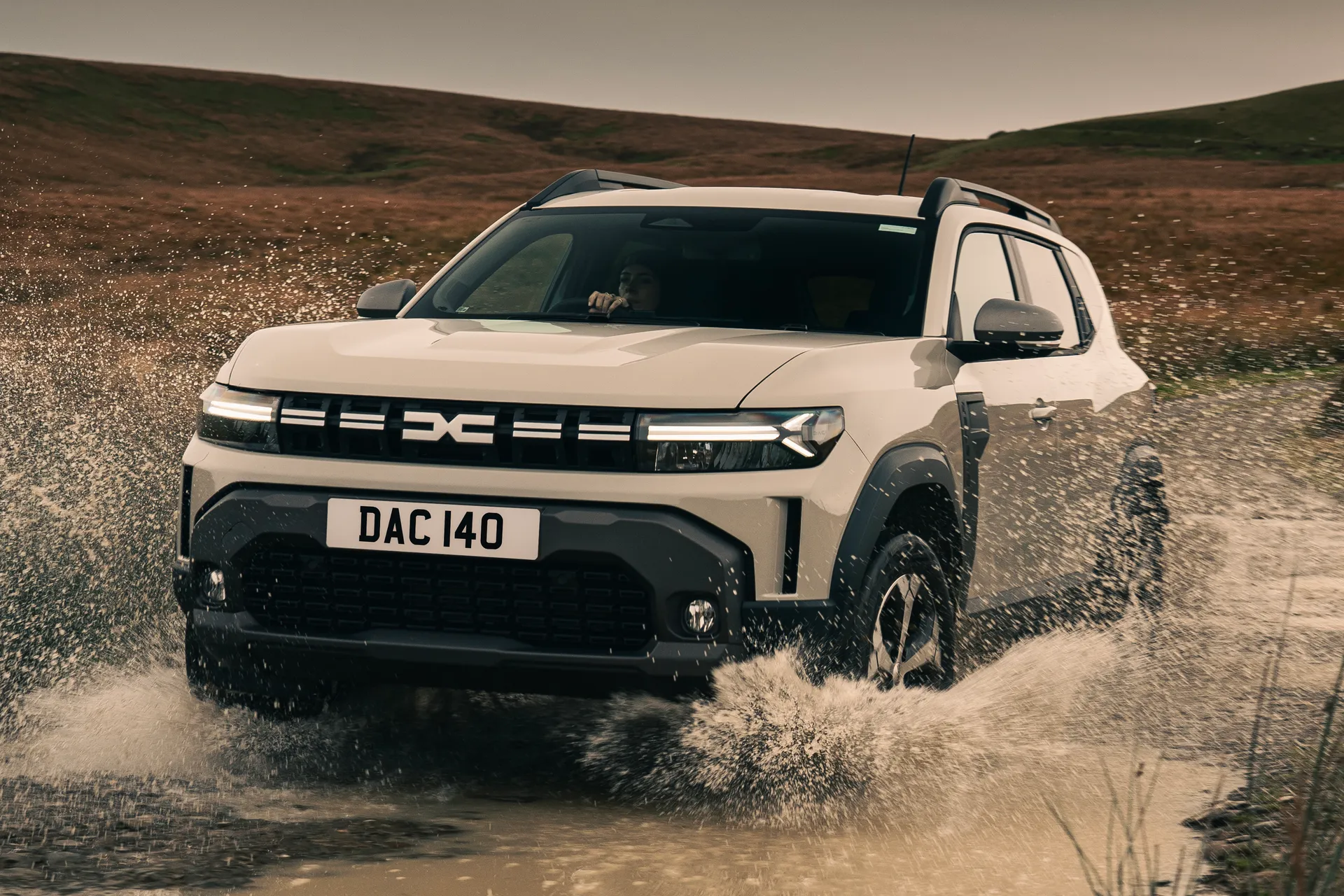
Many moons ago, SUVs were generally softly sprung to cope with unmade roads, which led to slightly wobbly on-road handling. More recently, almost all SUVs have taught suspension that trades some comfort for much better cornering ability. This Dacia Duster sits somewhere in between.
There is definitely less body lean than in the previous Duster and this one corners neatly. There's no drama or fuss, but none of the verve or fun you get with a Ford Puma. The Duster delivers decent steering feel through its not-quite-circular steering wheel. In town, it's easy to park and on the motorway there's ample stability, so it does the job just fine.
What Dacia has not done is try to make the Duster in any way sporty in its feel. This is a good thing in our book as it allows the Duster's supple suspension to dab away most ridges and dips so they don't upset the cabin's harmony. It's a pity, then, that there's more wind noise than in most of the Duster's competition, although it is improved over the previous model.
At lower speeds, this is not an issue, though the Hybrid 140's petrol engine can make a fair amount of racket when it decides to come into play. In electric mode, it's a far more pleasant car to drive.
The 4x4 version of the Duster is far more capable off-road than you would credit a car in this class. We tried it over far more rugged terrain than 99% of buyers will tackle and it performed with aplomb. It's no Land Rover, but for this price it's very impressive and will easily cope with a muddy field or rough farm track. There's a dial between the front seats that lets you choose between modes for different terrains, but to be honest the standard Auto mode will do the job.
What engines and gearboxes are available in the Dacia Duster?
There are three engines on offer in the Dacia Duster. The least powerful is the 100PS 1.0-litre dual-fuel only offered in base Essential trim. It can run on petrol or LPG (liquid petroleum gas), although 0-62mph in 14.1 seconds will have most buyers looking further up the range. Frankly, unless you are a died-in-the-wool LPG fan, there's no point to choosing this engine, especially as LPG is increasingly disappearing from UK forecourts.
Much better is the 1.2-litre three-cylinder TCe 130 engine. It offers 130PS and uses a six-speed manual gearbox in both front-wheel-drive and all-wheel-drive models. We'd stick with the front-drive version as its 0-62mph of 9.9 seconds is a good bit perkier than the all-wheel-drive's 11.0 seconds. However, both suffer from the same initial lag before the turbocharger wakes up and helps the Duster to surge forward. You get used this trait, but it means the engine is not as smooth and linear in its delivery as most rivals. Nor is it as quiet as Ford or Volkswagen's three-cylinder engines.
For off-road work, the Dacia Duster 4x4 has a part-time four-wheel-drive system that sends power to the rear wheels when needed. It comes with selectable drive modes for mud and sand, snow, and another that divides power equally between front and rear axles. There's also assistance to let the car creep at low speed over rocky outcrops, and a front camera to help see over sharp crests.
If you want an automatic gearbox in the Dacia Duster, you will be looking at the Hybrid 140 model. It uses a combination of 1.6-litre petrol engine and electric motor to produce 140PS, giving 0-62mph in 10.1 seconds. It's at its best when driving in EV mode, which it can for reasonably long periods at lower speeds even though it's not a plug-in hybrid. However, when the petrol motor comes into action, it's noisy and often makes a droning sound that undermines the Duster's refinement.
Refinement and noise levels
The Dacia Duster in Hybrid 140 form is a car of two halves. When driving in the EV setting, which it will do for much of the time at lower speeds, it's pleasingly quiet. However, when the petrol motor is needed, it does this with a very audible gurn that spoils this model in our view.
The 1.2-litre TCe 130 motor makes a typical three-cylinder burr when revved harder. It's a bit louder than a Volkswagen T-Roc's motor, but nothing to stop us choosing this as the best engine in the Duster range. We've yet to try the 1.0-litre petrol-LPG engine.
When it comes to wind noise, there's more inside the Dacia Duster than in a Skoda Kamiq or Nissan Qashqai. Countering this is minimal road noise from the tyres, at least on the 4x2 models, which come with summer tyres. The Duster 4x4 models come with all-season tyres, which we've not yet tried on the road.
Safety equipment: How safe is the Dacia Duster?
It's disappointing to note the Dacia Duster only scored three stars (out of five) from Euro NCAP when tested in mid-2024. It only managed middling scores for vulnerable road user and safety assist, but it did do well for child occupant safety. Dacia has said it doesn't fit the latest safety systems to its cars – beyond those legally required – because it doesn't believe its customers want to pay extra for them.
All models come with two Isofix child seat mounts in the outer rear chairs, as well as front passenger airbag deactivation so you can fit a third child seat if needed.
There are twin front and side airbags, fatigue detection, lane keep assist, forward collision warning and automatic emergency braking. You also get rear parking sensors, cruise control with speed limiter, traffic sign recognition, stability control, hill start assist. Handily, there is also a configurable driver assist system that lets you disable unwanted safety function at the touch of one button: ideal for turning off lane assist when driving on narrow country lanes.
MPG fuel costs: What does a Dacia Duster cost to run?
"The Hybrid 140 model should be the economy star of the range, but it's not that much better on consumption or emissions than the petrol-only model."
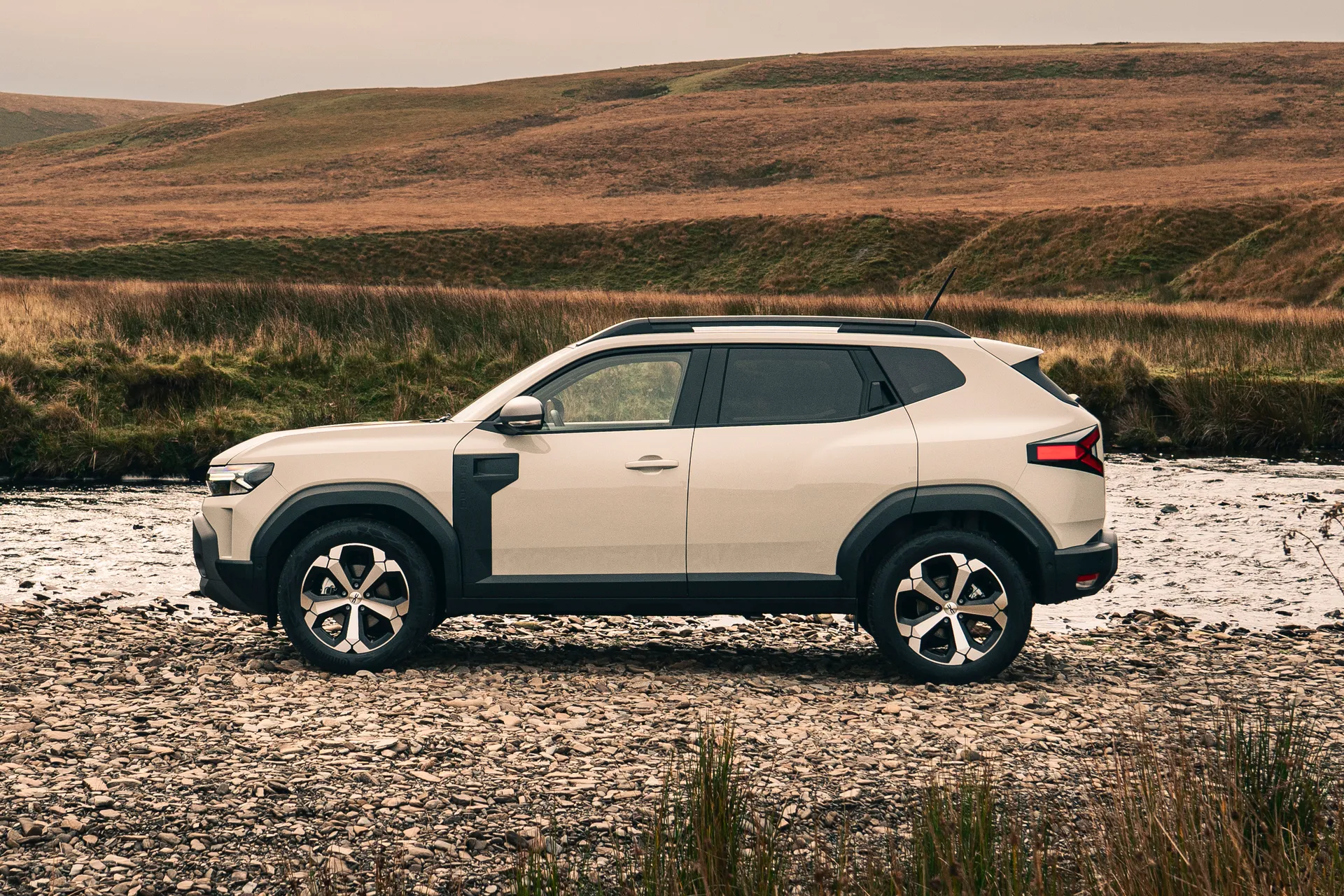
Given the added cost of choosing the Hybrid 140 version of the Dacia Duster, we'd expect it to offer significant costs savings, but it just doesn't. Granted, its 55.3mpg claimed combined economy is better than the front-drive TCE 130 Duster's 51.3mpg, but a 4mpg difference isn't worth the added cost or the Hybrid's poorer performance and refinement.
It's the same story with the petrol/LPG TCe 100 Bi-Fuel model. Running on liquid petroleum gas, it has an official consumption of 43.5mpg, while on petrol it claims 35.3mpg. Given the scarcity of LPG fuel stations, this fuel's lower price is not going to help much if you can't brim the tank routinely.
That leaves the 4x4 model of Dacia Duster, which shares the TCE 130 engine with the front-drive model. The extra weight and drag of the all-wheel drive transmission sees economy dip to a combined 46.3mpg. If you need this version's undoubted talents, that will be a price worth paying.
Dacia Duster reliability and warranty
The 1.0- and 1.2-litre engines in the Dacia Duster are the same as in the previous model, while the Hybrid's drivetrain is used in other Renault models. All have a solid reputation for working without fuss or hassle.
Dacia as a company scored a 12th-place ranking in the reliability standings of the most recent HonestJohn Satisfaction Survey. With 33 carmakers considered, that's ahead of the industry average, which is impressive for what is unashamedly a budget brand.
Dacia Duster insurance groups and costs
The insurance groups for the latest Dacia Duster are slightly higher than the previous model, which could mean higher premiums than existing owners are used to. The basic 1.0-litre Bi-Fuel model sits in group 17 of 50, but all other models are in either group 24 or 25.
VED car tax: What is the annual road tax on a Dacia Duster?
As of April 2025, all cars registered since 2017 are a subject to the same flat rate of Vehicle Excise Duty (VED, or road tax to give it the more familiar name) regardless of whether they run on petrol, diesel, hybrid or electricity. That flat rate currently stands at £195 per year.
Cars that cost more than £40,000 when brand new are also subject to a hefty additional sum for a temporary five-year period, but that's not something you'll have to worry about with the Duster, as no version gets remotely close to that threshold, even if you choose the top-spec car and load it up with every optional extra available.
Dacia Duster price
"When it first went on sale, the Dacia Duster cost from just £18,745 in its most basic form, but this has already risen to more like £19,400 in just a few short months. Even so, this is still very impressive for a family of this size."
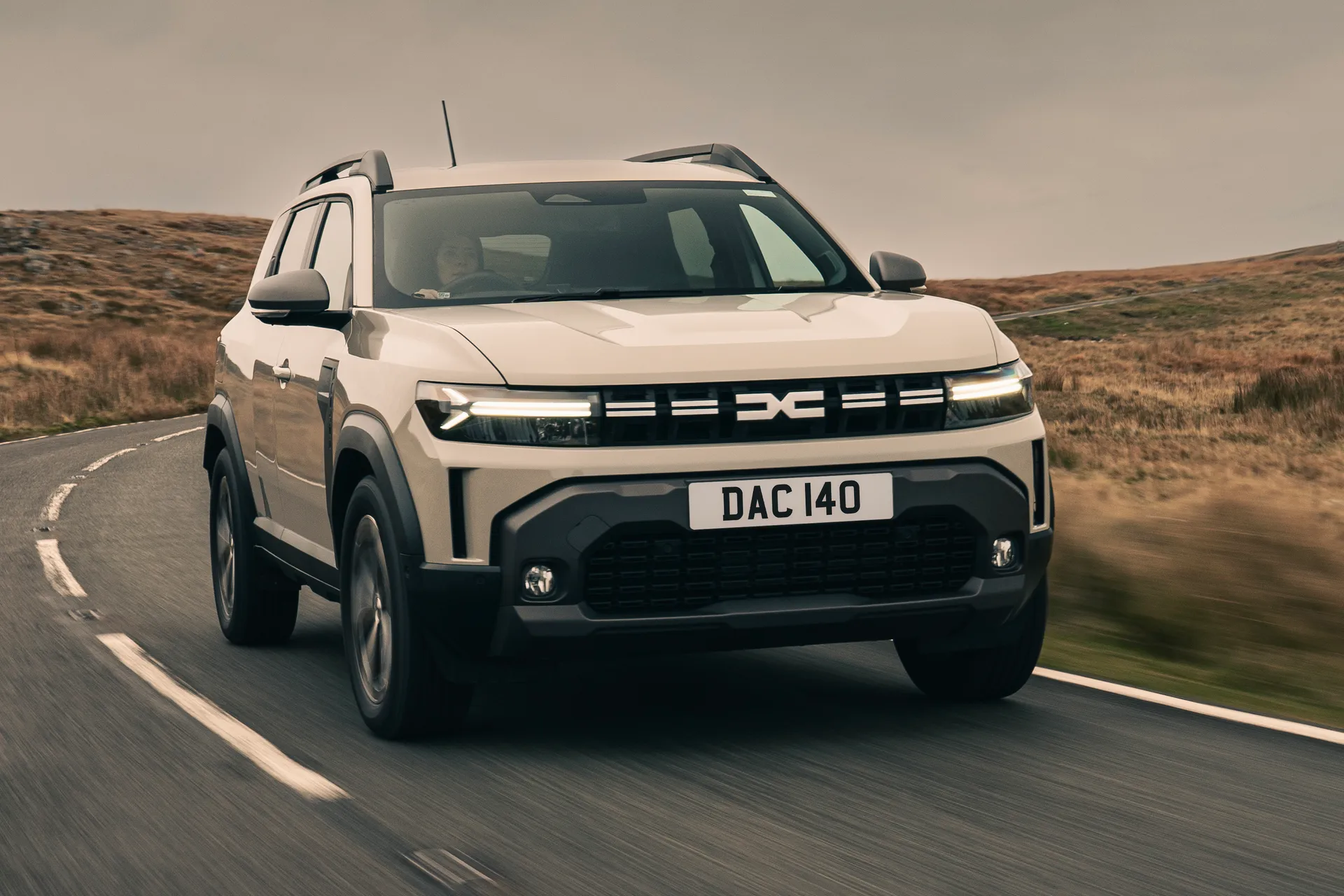
However, most buyers will - rightly - look past the entry-level model and go for something a little more salubrious. An Expression car with the mild hybrid petrol engine will probably hit the spot for many, and this one will cost you in the region of £22,000 if you buy brand new.
Dacias have historically enjoyed very strong resale values, due largely to the low prices on the new car market, and what's more, this latest generation of Duster is still new enough that there isn't a massive choice of pre-owned examples available on the used car market. This might have used car buyers worried, but there are deals to be had in the heycar classifieds. We've seen a few year-old examples of the full hybrid version with between 4,000 and 8,000 miles on them for two or three grand less than the brand new price, and you won't have to wait for your car to be built and shipped, either.
Trim levels and standard equipment
The starting point for the Dacia Duster range is the Essential trim, which is only offered with the TCe 100 Bi-Fuel engine. Due to what's under the bonnet and its pared-down spec, this is a model you'll probably want to bypass on the way to something better equipped.
What you get with the Essential are 16-inch steel wheels, roof bars, heated and electrically adjusted door mirrors, and rear parking sensors. You also have black cloth upholstery, electric front windows, manual air conditioning, a 3.5-inch radio display and four speakers.
Next in line is the Expression trim that adds the 10.1-inch infotainment screen, rear parking camera, and electric rear windows. It also comes with Denim-style upholstery, soft-feel steering wheel, automatic lights and wipers, grey mirror caps, and 17-inch alloy wheels. It has a height- and reach-adjustable steering wheel, too.
One rung up from this is the Journey trim that has sat-nav included with the infotainment, a multi-view camera, and front parking sensors. You also benefit from automatic air conditioning, a split parcel shelf, rear privacy glass, and 18-inch alloys.
At the top of the pile sits the Extreme model with its hill descent control for better off-road driving ability. Those in the front have heated seats, and the driver has a heated steering wheel. All of the seats are covered in synthetic leather upholstery, while the centre console has a sliding armrest. Outside, there are 18-inch alloy wheels, copper-coloured door mirror covers, and modular roof bars that make it easier to fit accessories to them.
Ask the heycar experts: common questions
Is the Dacia Duster just a Renault in different clothes?
Is the Hybrid 140 a plug-in hybrid?
How good is the Dacia Duster 4x4 off-road?
Get our latest advice, news and offers
Keep me updated by email with the latest advice, news and offers from heycar.
By submitting you agree to our privacy policy
